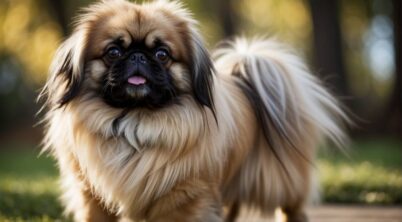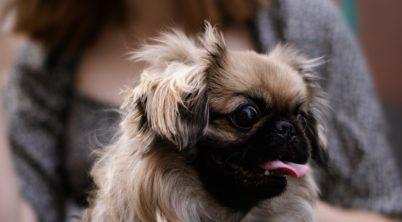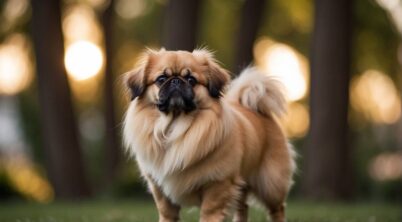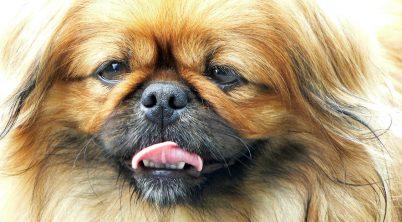The Pekingese, a toy breed esteemed for its regal demeanor and distinctive lion-like appearance, routinely captures the hearts of dog lovers and judges alike at the National Dog Show. Originating from China, this compact canine with a rolling gait exudes confidence and independence, attributes that often make it stand out in the highly competitive Toy Group. Their rich history as lap dogs of Chinese royalty adds to their allure, making their presence in the show ring not just a display of breed standards but a nod to a centuries-old legacy.
During the National Dog Show, the Pekingese competes in the Toy Group, showcasing its balanced, compact stature and famously luxurious coat among other diminutive breeds known for their companionship qualities. As a well-established event, the National Dog Show offers a platform where the Pekingese’s unique temperament, individuality, and distinct conformation are meticulously evaluated against its breed standard.
Participation in events such as the Pekingese Club of America (PCA) National Rotating Specialty, exemplifies the breed’s prominence within the dog show circuit. The Specialty, often held in conjunction with all-breed shows, provides Pekingese enthusiasts and breeders an opportunity to celebrate and evaluate the finest representatives of the breed, thereby influencing breeding programs aimed at preserving the breed’s esteemed characteristics for future generations.
Table of Contents
The Westminster Kennel Club Dog Show Legacy
The Westminster Kennel Club Dog Show is a prestigious event where Pekingese breeds have left a significant mark by winning multiple Best in Show titles, highlighted by notable champions and exceptional breed representatives such as Wasabi and Malachy.
Pekingese Wins at Westminster
The Westminster Kennel Club Dog Show, often simply known as Westminster, is a testament to the pedigree and poise of the Pekingese breed. A Pekingese named Wasabi became a symbol of excellence when it clinched the Best in Show title in 2021. This victory was celebrated on June 13, at the 145th Annual Westminster Kennel Club Dog Show held at the Lyndhurst Estate in Tarrytown, New York. Wasabi’s win not only showcased the breed’s distinctive beauty and character but also ensured the breed’s enduring legacy at one of the most highly regarded dog shows in the world.
Notable Pekingese Champions
The legacy of the Pekingese at Westminster is further illuminated by the achievements of notable champions. One such champion is Malachy, who triumphed with the Best in Show honor in 2012.
| Year | Champion | Noteworthy Fact |
|---|---|---|
| 2012 | Malachy | Trained and presented by professional handler David Fitzpatrick, this win added to the Pekingese prestige at Westminster |
| 2021 | Wasabi | A direct testament to the breed’s lasting appeal at the dog show and a nod to their showmanship |
These Pekingese champions, guided by handlers such as the esteemed David Fitzpatrick, have solidified the breed’s status at the show, repeatedly impressing judges and audiences with their lion-like mane, rolling gait, and serene composure under the spotlight.
The Role of Handlers in Dog Shows
At dog shows, handlers are integral in showcasing a dog’s best qualities and ensuring they perform well under the scrutiny of judges. They are responsible for the dog’s training, presentation, and often its transportation to the event.
Professional Handlers
Professional handlers are experts in presenting dogs in the show ring. They oftentimes provide a range of services including boarding, conditioning, training, and daily grooming. Key figures such as David Fitzpatrick, well-known for his work with Pekingese, exemplify the pinnacle of professional handling, having won numerous awards including the prestigious Best in Show at the Westminster Kennel Club dog show. Their expertise is not only in exhibiting dogs but also in understanding breed standards and the nuances of dog show etiquette.
- Training: Tailor sessions to each dog’s temperament and competition level.
- Grooming: Ensure the dog’s appearance meets breed standards.
- Presentation: Expertly display the dog’s attributes in the show ring.
Owner-Handlers
Alternatively, some exhibitors choose to be owner-handlers, taking on the role of trainer and presenter themselves. This can forge a strong bond between them and their dogs, which can translate into a more authentic and connected presentation in the show ring. Owner-handlers take full responsibility for their dog’s preparedness and are deeply involved in every step of the dog show process. They do not normally provide the breadth of services a professional handler might offer but can achieve a high level of success through dedication and expertise.
- Connection: Develop a unique rapport with their dog, potentially enhancing performance.
- Commitment: Fully immerse themselves in all aspects of their dog’s show preparation.
Handlers, whether professional or owner-handlers, are vital to the success of dogs in the competitive arena of dog shows. They bring out the best in the dogs they present, taking into account each animal’s individual needs and the high standards set by the competition.
Understanding Dog Show Categories and Groups
Dog shows categorize breeds into specific groups to evaluate them against their respective breed standards. Judges assess each dog’s adherence to these standards to determine group and overall winners.
Toy Group Essence
The Toy Group comprises the smaller dog breeds, known as toy breeds, which are bred primarily for companionship. Despite their diminutive size, they display a variety of temperaments and are known for their spirited and charming characteristics. In kennel club shows, the Toy Group is a prominent category under which breeds such as Pekingese have garnered significant attention and success. For instance, Pekingese dogs historically account for a substantial percentage of best-in-show wins within this group.
Judging the Breed Standard
When judges evaluate a dog, they are assessing how well the dog conforms to the breed standard, a set guideline that details the ideal characteristics for that breed. The aspects that judges may scrutinize include:
- Physical traits: such as the dog’s size, coat, color, and overall appearance.
- Temperament: assessing the dog’s behavior as it should reflect the standard associated with its breed.
- Gait and posture: how the dog carries itself, an important factor in many breed standards.
The toy breeds are judged similarly, with an understanding that their functionalities differ from those of larger breeds in other groups.
Betting in the World of Dog Shows
In the landscape of dog shows, such as the National Dog Show, betting has surfaced as an additional layer of engagement for adult audiences. This activity is not merely about predicting outcomes but also adds a dimension of entertainment to the event.
Approaching Dog Show Betting Responsibly
When it comes to betting on events like the National Dog Show, responsible gambling should be a paramount concern. NBC Universal, by showcasing dog competitions, has added PointsBet as an official sports betting partner, indicating that wagering on such events is welcomed for those who find it entertaining and do so responsibly.
- Platforms: Established betting platforms like PointsBet offer a way for viewers to participate in sports betting, specifically targeting those who have an interest in dog shows.
- Age restriction: Participants should be aware that sports betting is intended for adult audiences, and one must meet the legal gambling age requirements of their jurisdiction.
- Entertainment: Betting should be approached as a form of entertainment rather than a primary means to earn income.
To encourage responsible gambling, PointsBet and similar entities may provide:
- Resources: Tools to help individuals track their spending and time.
- Limits: Options to set limits on the amount one can bet or deposit.
- Self-exclusion: Features that allow users to exclude themselves from betting if needed.
Regarding compensation, entities like NBC Universal may receive payments when bets are placed through promotions or partner links associated with the event. However, it’s important for viewers to remember that gambling can be problematic if not managed correctly. Individuals facing a gambling problem should seek help and resources to address their challenges.
Memorable Moments in Dog Show History
The Pekingese breed has had an illustrious history in the world of dog shows, leaving a mark with memorable wins and the prestigious venues they’ve graced.
Pekingese Highlights
June 2021: A Pekingese named Wasabi became a sensation after winning Best in Show at the 145th Annual Westminster Kennel Club Dog Show. The event was held at the Lyndhurst estate in Tarrytown, New York and marked a significant achievement for the breed.
Notable Achievement: Wasabi, a top-ranked boy among his breed, continued the Pekingese legacy of success in professional dog shows, whereby showcasing the elegant and distinctive features that Pekingese are renowned for.
Historic Venues and Dates
Madison Square Garden: Traditionally, the Westminster Kennel Club Dog Show often took place at Madison Square Garden, one of the world’s most famous arenas, located in the heart of New York City.
Relocation and Dates:
- Lyndhurst Estate: Due to circumstances, such as the need for outdoor settings, the event moved to the scenic Lyndhurst estate in Tarrytown.
- Month of June: Typically, the Westminster Dog Show schedules its events in June, attracting crowds who anticipate the competition’s summer showcase.
The Impact of Pandemics on Dog Shows
The onset of the COVID-19 pandemic forced dog shows to adapt in unprecedented ways, with the Westminster Kennel Club Dog Show being no exception. Key adjustments to traditional operations were implemented to ensure the safety of handlers, judges, spectators, and the dogs themselves.
Covid-19 Protocols at Events
During the peak of the coronavirus pandemic, major dog shows, including the esteemed Westminster Kennel Club Dog Show, had to drastically alter their proceedings. Typically bustling with enthusiastic crowds, these events either had no public attendance or very limited audiences.
- Location Changes: The Westminster Kennel Club Dog Show, traditionally held in New York City, moved its venue to Tarrytown for the first time since its starting in 1877 to accommodate outdoor settings, allowing for more space and safer interactions.
- Health Safety Measures: Increased sanitization, mandatory mask-wearing, and social distancing procedures were standard. Exhibitors and staff were often required to be fully vaccinated against COVID-19 to participate.
The possibility of transmitting diseases such as fungal infections among dogs also meant that additional hygiene protocols were necessary, carefully balancing the well-being of the animals with the integrity of the competition.
These modifications ensured that, in spite of the challenges posed by the pandemic, the spirit of the competition continued, albeit under a very different setting. Dog shows, functioning as microcosms of larger societal events, navigated through the pandemic by embracing change and prioritizing health above all.
* Banner photo by Yi Su, cropped | Some rights reserved








